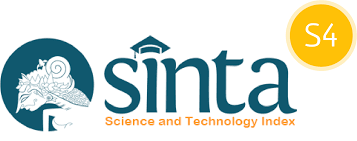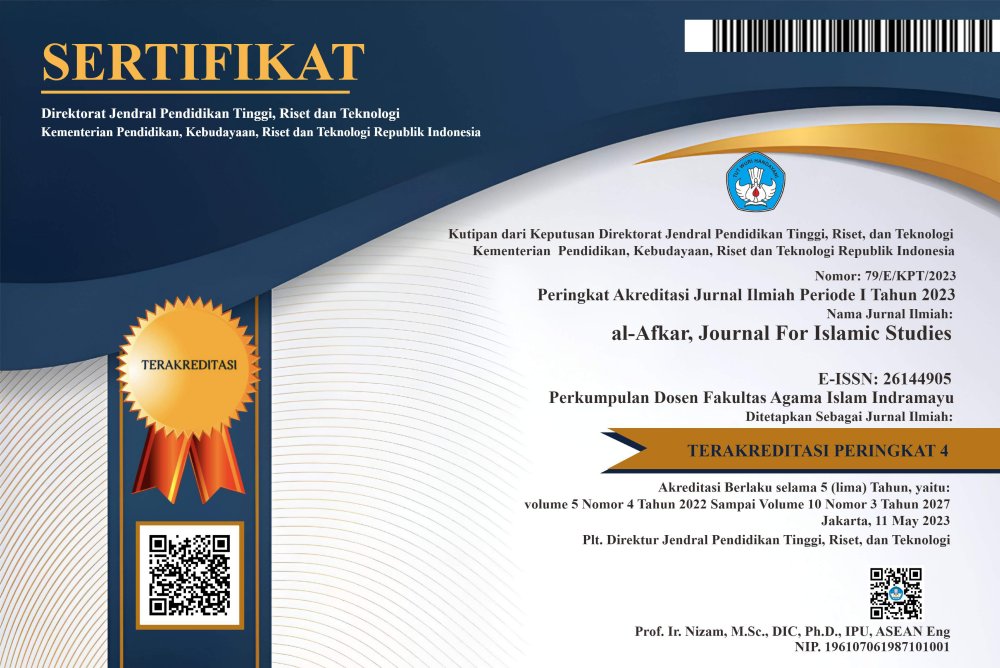Genealogy Magic in the Perspective of Mufassir Indonesia (QS. Al Baqarah (2): 102 Analysis Study)
DOI:
https://doi.org/10.31943/afkarjournal.v7i2.1000Keywords:
Nation, Ancient, Human, Modern, MagicAbstract
The history of magic is closely related to the civilization of Prophet Solomon, as well as the two figures named harut and marut. As narrated in the Qur'an, in surah al-Baqarah verse 102. Many scholars and mufasir poured their knowledge to study this verse so as to produce various views on it. Magic is considered a mistake and forbidden thing, as in Islam itself magic is a form of shirk, brings evil, and invites the wrath of Allah Subhanahu wa Ta'ala. However, how can things that are so forbidden and considered wrong, can actually spread widely to various parts of the world. This paper tries to understand the history of magic and various worldviews on magic, to its practice that still exists in modern society. This research is descriptive qualitative research that seeks to describe magical phenomena ranging from their history to their influence on different civilizations. As a result of this research, Allah Subhanahu Wa Ta'ala refuted the accusations against Prophet Solomon for the use of magic through his word, surah al-Baqarah verse 102. While various interpretations of who the real figure of harut and marut is. Behind all that, magic requires something as a payment to achieve its goals, ranging from animals to even human lives. Viewed from any side, magic is present as a test. If used, the practice is only to satisfy man's pseudo-desires and bring destruction to man himself.
Downloads
References
Achmad Zubairin. (2022). TAFSIR SUFISTIK SYAIKH NAWAWI AL-BANTANI. Al Dhikra | Jurnal Studi Qur’an Dan Hadis, 2(2). https://doi.org/10.57217/aldhikra.v2i2.778
Adiansyah, R., & Yahya, N. F. binti. (2022). KHAMR IN THE QUR’AN (THEMATIC STUDY OF TAFSIR IBN JARIR AL-TABARI). QiST: Journal of Quran and Tafseer Studies, 2(1), 1–17. https://doi.org/10.23917/qist.v2i1.1208
Abdul Kholiq, Al-Athar. Menolak Dan Membentengi Diri Dari Sihir. Bandung: Pustaka Hidayah, 1996.
AI-Asyqar, M S. Candu Mistik Menyingkap Rahasia Sihir Dan Perdukunan. Darul Falah, 2022. https://books.google.co.id/books?id=JK9-EAAAQBAJ.
Aizan Hj. Ali @ Mat Zin, and Mohd Yakub @ Zulkifli Hj Mohd Yusoff. Sejarah Amalan Sihir Di Zaman Para Nabi Menurut Sumber Tafsir Dan Hadith. Jurnal Usuluddin, 2003, 111–122.
Al-Jassas, Abu Bakar Ahmad al-Razi. Ahkaamu Al-Qur’an. Beirut: Dar al-Fikr, 1993.
Al-Muqbil. Membongkar Sihir Dan Perdukunan. Jakarta: Pustaka At-Tazkia, 2010.
Ashfahani. Al-Mufradât Fi Ghâribi al-Qurân. Beirut: Dâr al Ma’ârifah, n.d.
AYDAR, H. (2022). Osmanlı Tefsir Kültürüne Bir Katkı: Mehmed Fevzî Efendi’nin Tefrîcu’l-kalak fî tefsîri sûreti’l-Felak Adlı Sure Tefsirinin İşârî Yönden İncelenmesi. Tefsir Araştırmaları Dergisi, 6(2). https://doi.org/10.31121/tader.1124182
Fadli, N. (2023). CONTRIBUTION OF ACEHNESE SCHOLARS TO THE DEVELOPMENT OF QURANIC EXEGESIS IN INDONESIA: A STUDY OF TENGKU MUHAMMAD HASBI ASH-SHIDDIEQY AND HIS WORK “TAFSIR AN-NUUR.” QiST: Journal of Quran and Tafseer Studies, 3(1), 1–22. https://doi.org/10.23917/qist.v3i1.3381
Fikriyati, U., & Fawaid, A. (2022). SAVING LIVES AND LIMITING THE MEANS AND METHODS OF WARFARE Five Indonesian Tafsīr Views. Al-Jami’ah, 60(1), 167–198. https://doi.org/10.14421/ajis.2022.601.167-198
Hasan, M. Z. (2020). AL-QUR’AN SEBAGAI MEDIUM PENYEMBUHAN DALAM TRADISI “BEJAMPI” DI LOMBOK (Kajian Living Qur’an). El-’Umdah, 3(1). https://doi.org/10.20414/el-umdah.v3i1.2156
Hitami, Tomi. Kisah Harut Dan Marut Dalam Al-Qur’an (Telaah Penafsiran Syekh Nawawi Al-Bantani Atas Qur’an Surat Al-Baqarah Ayat 102 Dalam Tafsir Marah Labid). Universitas Islam Negeri Sultan Maulana Hasanuddin, 2021.
Hurmain. Dukun Black Magic Di Pasir Pangairian. Pekanbaru, 1989.
IAIN Syarif Hidayatullah. Ensiklopedi Islam Indonesia. Jakarta: Djambatan, 1992.
Ibnu al-Jauzi. Zad Al-Masir Fi Ilm al-Tafsir. Vol. 1. Beirut: Dar al-Kutub al-Ilmiyah, 2009.
Ibnu al-Manzhur. Lisan Al-’Arab. Vol. 4. Beirut: Dâr al Shâdir, n.d.
Ibnu Katsir. Al-Bidayah Wa An-Nihayah. II. Beirut: Maktabah al-Ma’arif, 1974.
Ibnu Khaldun. Al-Muqadimah. II. Beirut: Maktabatul Madrasah wa Darul Kitab Al-Lubnani, 1979.
Imam Ahmad, bin Muhammad bin Hambal. Musnad Ahmad. Edited by Fathurrahman Abdul Hamid, Ahmad Khotib, and Ahmad Rasyid Wahab. Terjemahan Indonesia. Vol. 19. Jakarta: Pustaka Azzam, 2007.
Imran Al-Idrusy. Mengenal Langkah-Langkah Setan. Surabaya: Putra Pelajar, 2001.
Ja’far, Muhammad. As-Sihr. Kairo: Maktabah Anglo Al-Mishriyah, 1985.
Jasmi, Kamarul Azmi. Bani Israil Dan Ilmu Sihir Serta Kisah Harut Dan Marut: Surah al-Baqarah (2: 99-103), 11 March 2019, 1–72.
Lubis, Mariati. Sihir Dalam Q.S Al-Baqarah:102 Menurut Tafsir Al-Maraghi Dan Tafsir Al-Misbah. Institut Agama Islam Negeri Padangsidimpuan, 2019.
Liu, Y. (2022). Paradigmatic Compatibility Matters: A Critical Review of Qualitative-Quantitative Debate in Mixed Methods Research. SAGE Open, 12(1). https://doi.org/10.1177/21582440221079922
M. Quraisy Shihab. Al-Lubab Makna, Tujuan, Dan Pelajaran Dari Surah-Surah al-Qur`an. Tangerang: Lentera Hati, 2012.
Muhammad Arifin Ilham. Panduan Zikir Dan Do’a. Jakarta: Bestar, 2007.
Nigar, N. (2020). Hermeneutic phenomenological narrative enquiry: A qualitative study design. Theory and Practice in Language Studies, 10(1), 10–18. https://doi.org/10.17507/tpls.1001.02
Nirwana AN, A., Nurrohim, A., Ash-Shiddiqi, I. J., Azizi, M., Agus, M., Lovely, T., Mas’ud, I., & Akhyar, S. (2023). PELATIHAN METODE TAJDIED UNTUK PENINGKATAN MEMBACA AL-QUR’AN SISWA SD MUHAMMADIYAH PROGRAM KHUSUS KOTTABARAT. Jurnal Pema Tarbiyah, 2(1). https://doi.org/10.30829/pema.v2i1.2361
Parwanto, W., & Engku Alwi, E. A. Z. (2023). the Pattern of Sufism on Interpretation of Q.S. Al-Fatihah in the Tafsir Manuscript By M. Basiuni Imran Sambas, West Kalimantan. QiST: Journal of Quran and Tafseer Studies, 2(2), 163–179. https://doi.org/10.23917/qist.v2i2.1472
Robbani, Naufal Tsaqif, and Andri Nirwana AN. Perkembangan Penafisiran Harut Dan Marut Dalam Kajian Tafsir Indonesia Periode 1900 - 2000. Edited by Alfiyatul Azizah. Kota Batu: PT. Azed Berkah Makmur, 2023.
Robiansyah, D., Syah, B. L., Pasetyo, A. E., & Afandi, A. N. M. (2022). Excessive Lifestyle According To Al Munir Tafsir By Wahbah Az Zuhaili. QiST: Journal of Quran and Tafseer Studies, 2(1), 18–43. https://doi.org/10.23917/qist.v2i1.1278
Rohman, A., Mubaroka, B., & Butlam, Q. (2023). Methodology of Tafseer Al-Qurtubi: Sources, Styles and Manhaj. QiST: Journal of Quran and Tafseer Studies, 2(2), 180–202. https://doi.org/10.23917/qist.v2i2.1451
Rozy, Y. F., Benichou, A., & Gafoordeen, N. (2023). THE HERMENEUTICS INFLUENCE ON FEMINIST EXEGESIS: A CASE STUDY ON AMINA WADUD. QiST: Journal of Quran and Tafseer Studies, 2(3), 369–381. https://doi.org/10.23917/qist.v2i3.2908
Saiin, A., & Karuok, M. (2022). the Concept of Sense in the Qur’an: Tazakkur, Nazara, and Tadabbur As the Basic Human Potential Towards a Superior Human Being. QiST: Journal of Quran and Tafseer Studies, 2(1), 44–62. https://doi.org/10.23917/qist.v2i1.1288
Saprudin, U., Junaedi, J., Kerwanto, K., & Anurogo, D. (2023). LIMITING THE NUMBER OF POLYGAMIES TO REALIZE ECONOMIC JUSTICE: A HERMENEUTIC ANALYSIS OF MUHAMMAD SYAHRUR. QiST: Journal of Quran and Tafseer Studies, 2(3), 347–368. https://doi.org/10.23917/qist.v2i3.2769
Shahnaz, S., & Zia, D. M. U. I. (2020). Magic - Its Nature and Role in the Light of “Tafseer Kabeer” of Imam Fakhr-ud-Din Razi. Fahm-i-Islam, 3(1). https://doi.org/10.37605/fahm-i-islam.3.1.1
Shihab, M. Q. (2000). Wawasan al-Qur’an Tafsir Maudhu’i Pelbagai Persoalan Umat. Mizan.
Sule, M. M. (2023). RESPONSE TO MUSLIMS DA’WAH ACTIVITIES’ BY NON-MUSLIMS IN AKWANGA AND NASSARAWA EGGON LOCAL GOVERNMENT AREAS OF NASARAWA STATE, NIGERIA. QiST: Journal of Quran and Tafseer Studies, 3(1), 23–39. https://doi.org/10.23917/qist.v3i1.3110
Syafruddin, D. (2014). Maḥmūd Yūnus wa Ittijāhātuhu fī Tahdīd Ta‘līm al-lughah al-‘Arabīyah bi Indūnīsīyā. Studia Islamika, 2(3). https://doi.org/10.15408/sdi.v2i3.831
Syantanawi, Ahmad. Funun As-Sihr. Kairo: Darul Ma’rifah, 1957.
Syarifah, N. (2020). TAFSIR AKADEMIK KARYA MAHMUD YUNUS: CORAK ILMIAH, SOSIAL DAN INTELEKTUAL DALAM TAFSIR AL-QUR’AN AL-KARIM. JURNAL At-Tibyan Jurnal Ilmu Alquran Dan Tafsir, 5(1). https://doi.org/10.32505/tibyan.v5i1.1157
Tamhid, Aunur Rafiq Shaleh. Sihir Dan Cara Pengobatannya Secara Islami. Terjemahan. Vol. 1. Jakarta: Robbani Press, 1995.
Wan Ahmad, W. H. S., Syed Bidin, S. N. B., & Mat Teh, K. S. (2017). Metode Pentafsiran Al-Ilmiy Hamka Dan Al-Maraghiy Terhadap Ayat-Ayat Al-Kawniyyah : Satu Perbandingan. Jurnal Islam Dan Masyarakat Kontemporari, 15(1).
Wajdi, Muhammad Farid. Dairatu Ma’arif Al-Qarni Al-Isyrin. II. Beirut: Darul Ma’rifah li Ath-Thiba’ah wa An-Nasyr, 1971.
Yaqut al-Hamawi. Mu’jam Al-Buldan. IX. Vol. I. Beirut: Dar Shadir, 2015.
Zahle, J. (2021). Objective data sets in qualitative research. Synthese, 199(1–2), 101–117. https://doi.org/10.1007/s11229-020-02630-2
Zulhamdi. (2020). Radha’ah in the perspective of Tafsir Al-Misbah. Samarah, 4(2), 545–567. https://doi.org/10.22373/sjhk.v4i2.6419
Downloads
Published
How to Cite
Issue
Section
License
Copyright (c) 2024 Sofyanto Raihan Pratama, Andri Nirwana AN, Agusni Yahya, Abd. Wahid

This work is licensed under a Creative Commons Attribution 4.0 International License.



















